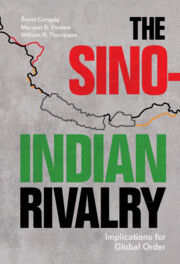Book contents
- The Sino-Indian Rivalry
- The Sino-Indian Rivalry
- Copyright page
- Contents
- Figures and Maps
- Tables
- Acknowledgments
- Part I Introduction
- Part II Spatial and Positional Considerations and Violence
- Part III The Evolution of the Rivalry
- Part IV Interconnected Rivalries and Systemic Considerations
- Part V Conclusion
- Chapter 9 Conclusion
- Bibliography
- Index
Chapter 9 - Conclusion
from Part V - Conclusion
Published online by Cambridge University Press: 15 June 2023
- The Sino-Indian Rivalry
- The Sino-Indian Rivalry
- Copyright page
- Contents
- Figures and Maps
- Tables
- Acknowledgments
- Part I Introduction
- Part II Spatial and Positional Considerations and Violence
- Part III The Evolution of the Rivalry
- Part IV Interconnected Rivalries and Systemic Considerations
- Part V Conclusion
- Chapter 9 Conclusion
- Bibliography
- Index
Summary
The China–India rivalry could be the key to global stability in the coming decades even though this may not be apparent at first. In Asia, the hotspots of Korea, Taiwan, the East China Sea, and the South China Sea tend to receive more attention, while the China–India militarized disputes are perceived as the backwaters of the regional theater. However, a Sino-Indian confrontation – whether on land in the Himalayas or in maritime realm in the Indian Ocean – may very well be the trigger that leads to a systemic war involving the United States. The China–India rivalry for power and influence at the regional level in Asia is in the process of fusing with the US–China rivalry in Asia and consequently at the global level. Given that the Sino-Indian spatial contest has intensified in recent years, the probability of escalation in the Himalayas is a distinct possibility. In fact, the presence of the more consequential positional dimension of the Sino-Indian rivalry suggests that there would still be a strong Sino-Indian rivalry even if the spatial dimension were to disappear. The Sino-Indian rivalry is now a part of the larger mosaic of regional and global power competition.
- Type
- Chapter
- Information
- The Sino-Indian RivalryImplications for Global Order, pp. 201 - 205Publisher: Cambridge University PressPrint publication year: 2023



